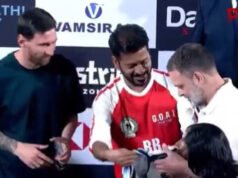Amid the excitement at the launch of The Wellness Co at the Gopichand Academy in Hyderabad, CE sat down with Pullela Gopichand, Chief National Coach of the Indian badminton team. He opened up about the collaboration, the cutting-edge therapies that stood out to him, and how this initiative is poised to transform recovery and performance for athletes. He also reflected on his own journey, milestones, wellness habits, and the evolution of Indian sport. In partnership with Rishabh Jain, founder of The Wellness Co, this isn’t just another clinic, it offers advanced therapies like Whole Body Cryotherapy, HBOT, PEMF and more under one roof. This collaboration brings world-class, science-backed wellness to a space long celebrated for athletic excellence.
Excerpts
How do you feel about this new wellness clinic opening at your academy?
I’m very excited. It’s a beautiful space. In today’s world, whether for athletes or anyone, health, longevity, and well-being have become priorities. What we’ve built here with The Wellness Co really stands out. From oxygen chambers to cryotherapy, hot-cold therapies, and advanced training modalities, there’s a lot to offer, not just for athletes, but for anyone looking to enhance their well-being.
What inspired your partnership with The Wellness Co?
As sportspersons, we’ve always needed these kinds of therapies. But finding them under one roof was almost impossible. We had to travel long distances for a hypoxic chamber, cryotherapy, or an infrared sauna. The Wellness Co offers all of this together, with expert guidance, the best technology, and a calming environment. That’s what made this collaboration feel right.

With therapies like cryotherapy, oxygen therapy, and red light therapy, how do you think this impacts recovery and performance?
Ice and cold therapy have always been part of an athlete’s recovery, whether it’s ice baths or cold packs. But cryo, both full-body and localised, takes it to another level. Adding oxygen therapy improves oxygenation, which hugely benefits recovery. When you combine this with infrared therapy and hot-cold contrast treatments, it creates a powerful toolkit, not just for faster recovery but also for enhancing performance.
Which therapy is your personal favourite?
I’ve always believed in the power of cold. Ice baths were a regular part of my playing days, and cryotherapy still feels like the most effective recovery tool for me.
How has the conversation around fitness and recovery shifted over the last decade in India?
It’s evolved tremendously. A decade ago, recovery was barely talked about. Today, it’s a key pillar of high performance. Government initiatives and greater awareness have pushed athletes and even non-athletes to focus on sleep, nutrition, oxygenation, and mental well-being. CEOs, entrepreneurs, and homemakers are now embracing wellness practices that were once reserved for elite athletes.
You’ve mentored champions. What’s been your proudest moment as a coach?
Every milestone has felt special — from winning a district or state title to coaching athletes who brought home Olympic and World Championship medals. Each time we break new ground — whether it’s the Thomas Cup, Badminton Asia Championships — it feels deeply rewarding.
As a player, what were your biggest challenges; physically or emotionally?
There were many. I underwent four knee surgeries. Thirty years ago, an ACL tear was almost a career-ending injury, but I was lucky to have great doctors. Cartilage and meniscus issues followed. Physically, it was painful; emotionally, it was exhausting. But overcoming those hurdles made the journey worthwhile. Watching today’s players succeed makes it all the more meaningful.
How has training for Indian athletes changed compared to your playing days?
The basics of hard training remain the same. But today, recovery, nutrition, physiotherapy, and sports science are far more integrated. Athletes now understand that it’s not just about the hours on court, it’s about how you recover, fuel your body, and maintain mental wellness.
Winning the All England Championship in 2001 was a historic moment. What stands out most from that experience?
The entire journey was magical. The All England has a legacy that every badminton player dreams of. Standing on that podium, in an arena where the legends played, was surreal. It was the fulfilment of a childhood dream and remains one of the most cherished memories of my life.
Off the court, how do you relax? Any wellness habits you swear by?
I meditate regularly and practise Yoga Nidra. Long walks are my go-to. On off days, I prefer being at home, resting and catching up on sleep. Recently, I’ve been reading a book on Adi Shankaracharya, which I found truly inspiring.
Was the transition from player to coach difficult?
Not really. Coaching feels like an extension of playing. I still show up every day in T-shirt and shorts, spending my life on the court, 30 years on. That’s a privilege I cherish deeply.
You often speak about spirituality and mental strength. How do they influence your coaching and life?
For me, there’s no difference between who I am personally and who I am spiritually. If your heart is pure, your mind clear, and your thoughts honest, it enhances not just your performance but also how you handle failure, success, and life itself.






